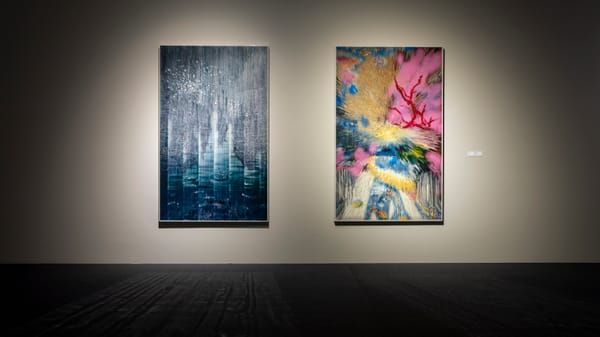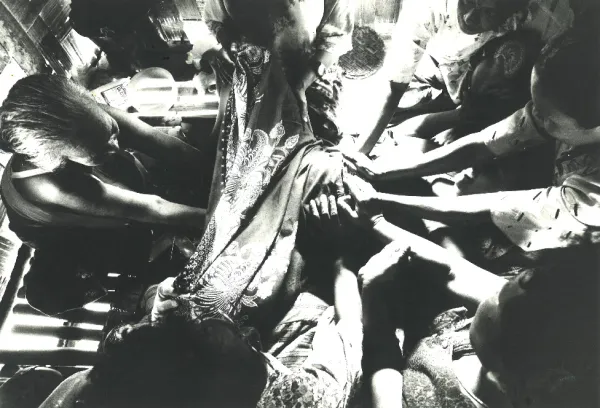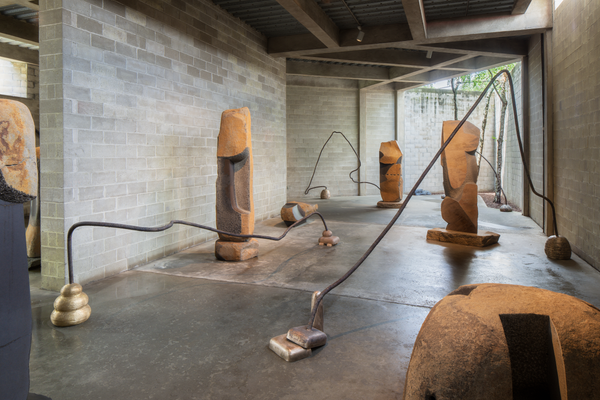Shows
“After Utopia: Revisiting The Ideal In Asian Contemporary Art”


Inside the historic 160-year-old building of the Singapore Art Museum (SAM), a disco party is underway. Majestic torpedo bombs hang from the ceiling, their mirrored surfaces glittering and twinkling to dance music. Filipino artist Kawayan de Guia’s shimmering installation Bomba (2011), set inside a space within the museum that was once the chapel of a former Catholic boys school, evokes the hedonistic pleasures and exuberant consumption that define the global corruption and economic inequalities of today. What happens—it seems to ask—after the bombs fall?
This question is one of several that is probed in SAM’s latest exhibition. At the heart of “After Utopia: Revisiting the Ideal in Asian Contemporary Art” is the enduring quest for paradise in a troubled world of convoluted political systems and failed social principles. A selection of works by 18 artists and artist’s collectives drawn largely from SAM’s permanent collection, as well as one new commission, share the universal theme of examining “humanity’s eternal yearning for a better world.”

On the ground floor, nature and urbanization are put in antithetical contention. Singaporean abstract artist Ian Woo’s sublime painting of dense shrubbery transports visitors into the garden paradise of Eden. On a nearby wall is Manila-based Geraldine Javier’s painting of a woman reminiscent of both Eve and Mexican artist Frida Kahlo, which is an interpretation of the passion and suffering the latter figure is known to have endured in both her artistic and personal life. Standing in a lush garden and surrounded by preserved butterflies encased in cushioned frames, Javier’s Ella Amo’ Apasionadamente y Fue Correspondida (For She Loved Fiecrely, and She is Well-Loved) (2010) references the religious teachings of Eve’s (and Adam’s) shameful fall from grace, eternally forbidden to reap the benefits of Eden. The deeply complex and feminine painting is also a self-portrait of Javier and alludes to the difficulties and challenges of being both a woman and an artist in the Philippines.
Arguably the most notorious piece in the exhibition is Indonesian artists Agus Suwage and Davy Linggar’s Pinkswing Park (2005/2012). Since inciting controversy at the time of its premiere in Indonesia, the work is on view to the public for the first time in ten years. The installation was originally conceived for the short-lived CP Biennale in Jakarta, but was taken down by authorities following protests from local fundamentalist groups who felt the work was pornographic and deplorable for its allusion to Adam and Eve. Suwage and Linggar's rendition of Eden contains a baby-pink swing made from a becak (an Indonesian rickshaw) and has walls that are plastered with images of an idyllic garden and two Indonesian pop stars who are playfully posing naked as famous nude figures from Western art history. Yet the deliberate censoring of their genitalia with big dots suggests that the two figures are acutely aware of their state of undress. This modern Eden is deliberately rife with stifling censorship and filtering—unable to qualify as a true utopia.
Staying in dystopian Indonesia, artist Maryanto’s site-specific commission, a charcoal mural entitled Pandora’s Box (2013/2015), features a panoramic view of what looks to be free, open fields; but a closer look at this ideal state unveils the inevitable tragedies that result from the exploitation of lush, native resources. The three walls of the mural depict a bleak, ravaged landscape and are a composite of several real sites in Indonesia that the artist has witnessed being depleted by industrialization.

In the next area, contemporary urban living comes under scrutiny in another version of (a failed) utopia. Video works by American artist Shannon Lee Castleman and Malaysia’s Chris Chong Chan Fui draw attention to the cramped housing conditions of Singapore and neighboring Kuala Lumpur, highlighting the dystopian reality of high-density urbanization, and preying on the voyeuristic impulses innate in all of us.
Upstairs, the notion of Shangri-la takes shape in the form of grand philosophies and sociopolitical narratives. Consumer capitalism has the last laugh in the work of Vietnamese-American artist collective The Propeller Group, with its critique of Communism. Employing the expertise of TBWA, a global advertising agency, The Propeller Group created Television Commercial for Communism (2011–12) as an attempt to disguise the stigma associated with socialist beliefs, branding its ideals with positive images and an all-white design concept, packaged clean, crisp and consumerist friendly.
Meanwhile, Chinese-Australian artist Shen Shaomin tackles the broken ideologies of Communism in Summit (2009). Hyper-realistic sculptural renditions of leftist political leaders encased in transparent casket-like boxes elicit visions of a funeral wake. The depiction of their mortality serves as a reminder of the fickleness at the heart of many political schemes. On one side lies Cuban revolutionary Fidel Castro lying on his deathbed; his ever-so-slightly and spine-chillingly heaving chest shows that he is "breathing," but barely. It appears that Communism, despite all the glory of its utopian promises, is having its final breath, and the impending failure of its philosophies is creeping just around the corner.

Nearing its end, the exhibition makes one final attempt at seeking nirvana by turning attention to the inner psyche. Cambodian artist Svay Sareth's video installation Mon Boulet (2011) documents his soul-searching journey as he walks for six days from his native Siem Reap to the capital city of Phnom Penh, all the while hauling a two-meter-wide metal sphere behind him. What Mon Boulet (2011) represents, the curators hope, is the possibility that utopia could be found in our inner minds through an intimate pursuit of the self. At SAM, the 80-kilogram ball from the performance, in all its dented and scratched glory, has found its final resting place within the gallery walls, alongside the documentary video of Svay’s journey. Meanwhile, in a test of endurance and mindfulness, Thai artist Kamin Lertchaiprasert painstakingly carved one sculpture a day over the course of one leap year. The 366 hand-carved figures in meditative poses call for quiet inspection and hints that the quest for paradise may indeed be a private search.
In Greek semantics, the word utopia is defined as both “good place” and “no place” at the same time. So is utopia attainable? The works in this exhibition demonstrate that locating utopia is, and may forever remain, merely a fleeting endeavor. Utopia will eternally escape our grasps, or perhaps this concept is preordained to exist only as a dream.
“After Utopia: Revisiting the Ideal in Asian Contemporary Art” is on view at Singapore Art Museum until October 18, 2015.
Denise Tsui is assistant editor at ArtAsiaPacific.







